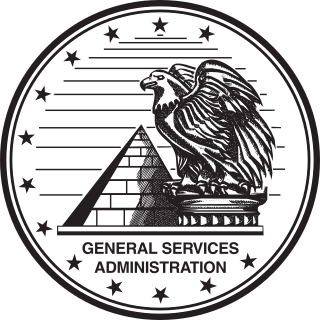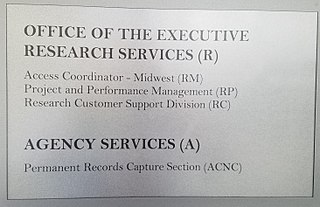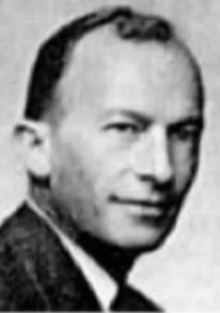History
The Federal Records Act was created following the recommendations of the Hoover Commission (1947-49). [1] It implemented one of the reforms proposed by Emmett Leahy in his October 1948 report on Records Management in the United States Government, with the goal of ensuring that all federal departments and agencies had a program for records management. [2]
The act, and its related regulations, require each federal agency to establish an ongoing program for record management and to cooperate with the National Archives and Records Administration (NARA). [1] A 1985 NARA pamphlet describes the Federal Records Act as the "basis for the Federal Government's policies and procedures for creating, maintaining, and disposing of Federal records. The act and its related regulations define Federal records, mandate the creation and preservation of those records necessary to document Federal activities, establish Government ownership of records, and provide the exclusive legal procedures for the disposition of records." [1] The Second Hoover Commission (1953-55) addressed paperwork management and recommended the adoption of a program relating to "directives management, reports management, paperwork quality control, and clerical work measurement." As a result, the first Guide to Record Retention Requirements was published in 1955. This guide is updated annually and is used by archivists and other record managers both in and out of government. [1]
The Federal Records Act was amended over time. Amendments in 1976 emphasized paperwork reduction and information lifecycle management. [1] The Paperwork Reduction Act of 1980, which followed the issuance of the report of the Commission on Federal Paperwork in 1977, introduced information resources management and gave responsibility to the Office of Management and Budget for creating federal information policy standards. [1]
In November 2014, the Presidential and Federal Records Act Amendments of 2014 was signed into law by President Barack Obama. [3] [4] This bipartisan act, which followed the 2011 President's Memorandum on Managing Government Records, modernizes the Federal Records Act. [3] [4] The act expressly expands the definition of federal records to include electronic records (the first change to the definition of "Federal record" since the enactment of the act in 1950). [3] [4] The act also grants the Archivist of the United States the final determination as to what constitutes a Federal record; "authorizes the early transfer of permanent electronic federal and presidential records to the National Archives, while legal custody remains with the agency or the president"; "clarifies the responsibilities of federal government officials when using non-government email systems"; and "empowers the National Archives to safeguard original and classified records from unauthorized removal." [3] [4]

The United States Department of Commerce (DOC) is an executive department of the U.S. federal government concerned with creating the conditions for economic growth and opportunity.

The National Archives and Records Administration (NARA) is an independent agency of the United States government within the executive branch, charged with the preservation and documentation of government and historical records. It is also tasked with increasing public access to those documents that make up the National Archives. NARA is officially responsible for maintaining and publishing the legally authentic and authoritative copies of acts of Congress, presidential directives, and federal regulations. NARA also transmits votes of the Electoral College to Congress. It also examines Electoral College and constitutional amendment ratification documents for prima facie legal sufficiency and an authenticating signature.

The General Services Administration (GSA) is an independent agency of the United States government established in 1949 to help manage and support the basic functioning of federal agencies. GSA supplies products and communications for U.S. government offices, provides transportation and office space to federal employees, and develops government-wide cost-minimizing policies and other management tasks.

In the United States, the presidential library system is a nationwide network of 16 libraries administered by the Office of Presidential Libraries, which is part of the National Archives and Records Administration (NARA). These are repositories for preserving and making available the papers, records, collections and other historical materials of every president of the United States since Herbert Hoover, the 31st president from 1929–1933. In addition to the library services, museum exhibitions concerning the presidency are displayed.

The Office of Information and Regulatory Affairs is a Division within the Office of Management and Budget (OMB), which in turn, is within the Executive Office of the President. OIRA oversees the implementation of government-wide policies in, and reviews draft regulations under, Executive Order 12866, the Paperwork Reduction Act, and the Information Quality Act.

The Archivist of the United States is the head and chief administrator of the National Archives and Records Administration (NARA) of the United States. The Archivist is responsible for the supervision and direction of the National Archives.

Trudy Huskamp Peterson is the first woman to hold the position of Archivist of the United States. She was the Acting Archivist of the United States from March 25, 1993 to May 29, 1995.

Executive Order 13233 limited access to the records of former United States Presidents to a higher degree than the previous Order 12667, which it superseded. It was drafted by then White House Counsel Alberto Gonzales and issued by George W. Bush on November 1, 2001. Section 13 of Order 13233 revoked Executive Order 12667 which was issued by Ronald Reagan on January 18, 1989.

The Paperwork Reduction Act of 1980 is a United States federal law enacted in 1980 designed to reduce the total amount of paperwork burden the federal government imposes on private businesses and citizens. The Act imposes procedural requirements on agencies that wish to collect information from the public. It also established the Office of Information and Regulatory Affairs (OIRA) within the Office of Management and Budget (OMB), and authorized this new agency to oversee federal agencies' collection of information from the public and to establish information policies. A substantial amendment, the Paperwork Reduction Act of 1995, confirmed that OIRA's authority extended over not only agency orders to provide information to the government, but also agency orders to provide information to the public.

The Presidential Records Act (PRA) of 1978, 44 U.S.C. §§ 2201–2209, is an Act of the United States Congress governing the official records of Presidents and Vice Presidents created or received after January 20, 1981, and mandating the preservation of all presidential records. Enacted November 4, 1978, the PRA changed the legal ownership of the President's official records from private to public, and established a new statutory structure under which Presidents must manage their records. The PRA was amended in 2014, to include the prohibition of sending electronic records through non-official accounts unless an official account is copied on the transmission, or a copy is forwarded to an official account shortly after creation.
The Joint Staff Information Management Division (IMD) is one of two divisions which make up the Joint Staff Secretariat (SJS) of the United States Joint Chiefs of Staff currently located in the Pentagon in Arlington, Virginia (USA). The other division is called Actions Division (AD) which manages the daily workflow of the staff.

Records life-cycle in records management refers to the following stages of a records "life span": from its creation to its preservation or disposal. While various models of the records life-cycle exist, they all feature creation or receipt, use, and disposition.

Beryl Alaine Howell is an American lawyer and jurist who serves as a senior United States district judge of the United States District Court for the District of Columbia. She was district's chief judge from 2016 to 2023. As chief judge, she supervised federal grand juries in the District, including for the Mueller special counsel investigation into Russian interference in the 2016 United States elections and investigations into attempts to overturn the 2020 United States presidential election.

Theodore Roosevelt Schellenberg was an American archivist and archival theorist. Schellenberg's publications and ideas are part of the foundation for archival theory and practice in the United States. In particular, Schellenberg is known for pioneering American archival ideas about appraisal.

The Presidential and Federal Records Act Amendments of 2014 is a United States federal statute which amended the Presidential Records Act and Federal Records Act. Introduced as H.R. 1233, it was signed into law by President Barack Obama on November 26, 2014.
A machine-readable document is a document whose content can be readily processed by computers. Such documents are distinguished from more general machine-readable data by virtue of having further structure to provide the necessary context to support the business processes for which they are created.

The organization of the National Archives and Records Administration refers to the administrative and bureaucratic structure of the National Archives and Records Administration of the United States. The National Archives is considered an independent federal government agency, receiving this status in 1985 after existing under the General Services Administration since the National Archives' founding in 1934.

Emmett Joseph Leahy was an American archivist and entrepreneur. He was a pioneer in the discipline of records management. After working in the National Archives and then during World War II in the United States Navy, he entered private business as a consultant in records management and as a records storage provider. He also participated in the two Hoover Commissions in improving the efficiency and effectiveness of government.
Kenneth Francis Thibodeau is an American specialist in electronic records management who worked for many years at the National Archives and Records Administration (NARA). He was responsible for development of the pioneering DoD 5015.02 standard for electronic records management and for creation of NARA's Electronic Records Archives System (ERA).













